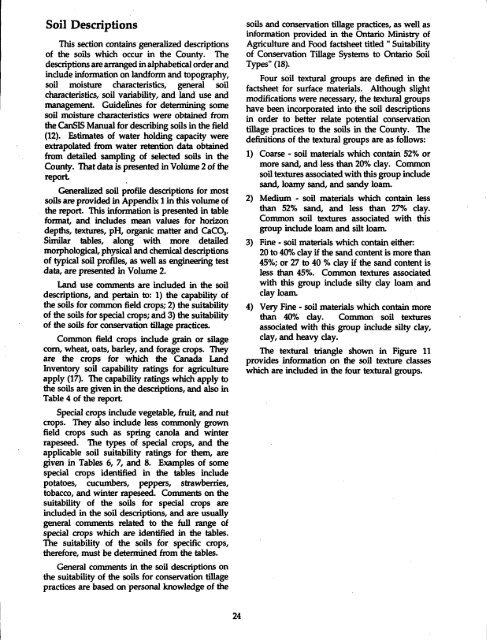The Soils of Elgin County - Agriculture and Agri-Food Canada
The Soils of Elgin County - Agriculture and Agri-Food Canada
The Soils of Elgin County - Agriculture and Agri-Food Canada
- No tags were found...
Create successful ePaper yourself
Turn your PDF publications into a flip-book with our unique Google optimized e-Paper software.
Soil DescriptionsThis section contains generalized descriptions<strong>of</strong> the soils which occur in the <strong>County</strong> . <strong>The</strong>descriptions arearranged in alphabetical order<strong>and</strong>include information on l<strong>and</strong>form <strong>and</strong> topography,soil moisture characteristics, general soilcharacteristics, soil variability, <strong>and</strong> l<strong>and</strong> use <strong>and</strong>management . Guidelines for determining somesoil moisture characteristics were obtained fromthe CânSIS Manual for describing soils in the field(12). Estimates <strong>of</strong> water holding capacity wereextrapolated from water retention data obtainedfrom detailed sampling <strong>of</strong> selected soils in the<strong>County</strong>. That data is presented in Voliune 2 <strong>of</strong> thereportGeneralized soil pr<strong>of</strong>ile descriptions for mostsoils are provided in Appendix 1 in this volume <strong>of</strong>the report. This information is presented in tableformat, <strong>and</strong> includes mean values for horizondepths, textures, pH, organic matter <strong>and</strong> CaC03 .Similar tables, along with more detailedmorphological, physical <strong>and</strong> chemical descriptions<strong>of</strong> typical soil pr<strong>of</strong>iles, as well as engineering testdata, are presented in Volume 2 .L<strong>and</strong> use comments are included in the soildescriptions, <strong>and</strong> pertain to : 1) the capability <strong>of</strong>the soils for common field crops; 2) the suitability<strong>of</strong> the soils for special crops, <strong>and</strong> 3) the suitability<strong>of</strong> the soils for conservation tillage practices.Common field crops include grain or silagecorn, wheat, oats, barley, <strong>and</strong> forage crops . <strong>The</strong>yare the crops for which the <strong>Canada</strong> L<strong>and</strong>Inventory soil capability ratings for agricultureapply (17) . <strong>The</strong> capability ratings which apply tothe soils are given in the descriptions, <strong>and</strong> also inTable 4 <strong>of</strong> the reportSpecial crops include vegetable, fruit, <strong>and</strong> nutcrops. <strong>The</strong>y also include less commonly grownfield crops such as spring canola <strong>and</strong> winterrapeseed. <strong>The</strong> types <strong>of</strong> special crops, <strong>and</strong> theapplicable soil suitability ratings for them, aregiven in Tables 6, 7, <strong>and</strong> 8. Examples <strong>of</strong> somespecial crops identified in the tables includepotatoes, cucumbers, peppers, strawberries,tobacco, <strong>and</strong> winter rapeseed. Comments on thesuitability <strong>of</strong> the soils for special crops areincluded in the soil descriptions, <strong>and</strong> are usuallygeneral comments related to the full range <strong>of</strong>special crops which are identified in the tables .<strong>The</strong> suitability <strong>of</strong> the soils for specific crops,therefore, must be determined from the tables .General comments in the soil descriptions onthe suitability <strong>of</strong> the soils for conservation tillagepractices are based on personal knowledge <strong>of</strong> thesoils <strong>and</strong> conservation tillage practices, as well asinformation provided in the Ontario Ministry <strong>of</strong><strong><strong>Agri</strong>culture</strong> <strong>and</strong> <strong>Food</strong> factsheet titled " Suitability<strong>of</strong> Conservation Tillage Systems to Ontario SoilTypes" (18) .Four soil textural groups are defined in thefactsheet for surface materials . Although slightmodifications were necessary, the textural groupshave been incorporated into the soil descriptionsin order to better relate potential conservationtillage practices to the soils in the <strong>County</strong>. <strong>The</strong>definitions <strong>of</strong> the textural groups are as follows :1) Coarse - soil materials which contain 52% ~ormore s<strong>and</strong>, <strong>and</strong> less than 20% clay. Commonsoil textures associated with this group includes<strong>and</strong>, loamy s<strong>and</strong>, <strong>and</strong> s<strong>and</strong>y loam.2) Medium - soil materials which contain lessthan 52% s<strong>and</strong>, <strong>and</strong> less than 27% clay .Common soil textures associated with thisgroup include loam <strong>and</strong> silt loam.3) Fine - soil materials which contain either:20 to 40% clay if the s<strong>and</strong> content is more than45%; or 27 to 40 % clay if the s<strong>and</strong> content isless than 45%. Common textures associatedwith this group include silty clay loam <strong>and</strong>clay loam.4) Very Fine - soil materials which contain morethan 40% clay . Common soil texturesassociated with this group include silty clay,clay, <strong>and</strong> heavy clay.<strong>The</strong> textural triangle shown in Figure 11provides information on the soil texture classeswhich are included in the four textural groups.24
















